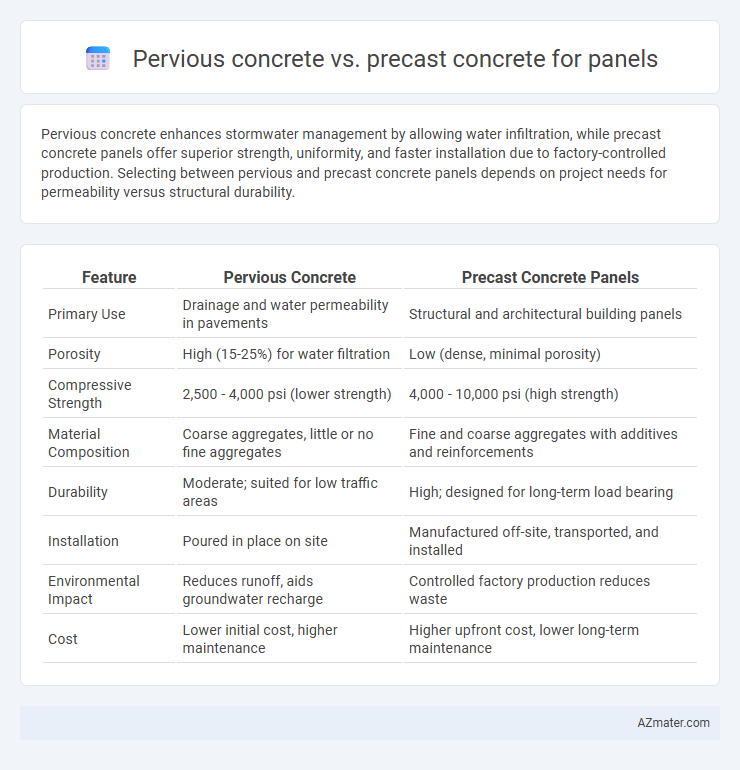Pervious concrete enhances stormwater management by allowing water infiltration, while precast concrete panels offer superior strength, uniformity, and faster installation due to factory-controlled production. Selecting between pervious and precast concrete panels depends on project needs for permeability versus structural durability.
Table of Comparison
| Feature | Pervious Concrete | Precast Concrete Panels |
|---|---|---|
| Primary Use | Drainage and water permeability in pavements | Structural and architectural building panels |
| Porosity | High (15-25%) for water filtration | Low (dense, minimal porosity) |
| Compressive Strength | 2,500 - 4,000 psi (lower strength) | 4,000 - 10,000 psi (high strength) |
| Material Composition | Coarse aggregates, little or no fine aggregates | Fine and coarse aggregates with additives and reinforcements |
| Durability | Moderate; suited for low traffic areas | High; designed for long-term load bearing |
| Installation | Poured in place on site | Manufactured off-site, transported, and installed |
| Environmental Impact | Reduces runoff, aids groundwater recharge | Controlled factory production reduces waste |
| Cost | Lower initial cost, higher maintenance | Higher upfront cost, lower long-term maintenance |
Introduction to Pervious Concrete and Precast Concrete Panels
Pervious concrete panels allow water to permeate through their porous structure, reducing runoff and enhancing stormwater management in urban environments. Precast concrete panels are manufactured off-site under controlled conditions, ensuring uniform quality and rapid installation for building facades, walls, and infrastructure projects. Both materials offer distinct functional benefits, with pervious concrete emphasizing environmental sustainability and precast concrete focusing on durability and construction efficiency.
Material Composition and Properties
Pervious concrete consists of a mixture of cement, coarse aggregates, and little to no fine aggregates, enabling high porosity and water permeability, which enhances stormwater management and reduces runoff. Precast concrete panels are made from a dense composition of cement, fine and coarse aggregates, and admixtures, resulting in high compressive strength, durability, and uniform quality controlled in a factory environment. The porous structure of pervious concrete contrasts with the dense, non-porous nature of precast panels, influencing their respective applications in drainage and structural components.
Manufacturing Process Comparison
Pervious concrete panels require a careful batching process to maintain high porosity, involving low cement content and an optimized aggregate size distribution to allow water infiltration post-curing. Precast concrete panels are manufactured in controlled factory settings with precise molding, vibration, and curing techniques to achieve uniform strength and surface finish. The pervious concrete process demands accelerated curing methods to preserve permeability, whereas precast panels typically undergo standardized steam curing for enhanced durability and dimensional stability.
Structural Performance Differences
Pervious concrete provides superior permeability and drainage, reducing hydrostatic pressure on panels, whereas precast concrete offers enhanced uniformity and higher compressive strength due to controlled factory conditions. Structural performance of pervious concrete panels emphasizes load-bearing capacity with simultaneous water flow management, while precast panels excel in dimensional accuracy and resistance to environmental stressors. The choice between pervious and precast concrete panels depends highly on specific project requirements such as drainage needs and structural load demands.
Thermal and Acoustic Insulation
Pervious concrete panels offer superior thermal insulation by allowing air permeability, reducing heat transfer and enhancing energy efficiency in buildings. In contrast, precast concrete panels provide denser material properties that deliver better acoustic insulation, effectively dampening sound transmission through walls. Selecting between pervious and precast concrete panels depends on prioritizing either enhanced airflow and thermal regulation or robust noise reduction capabilities.
Sustainability and Environmental Impact
Pervious concrete enhances sustainability by allowing water infiltration, reducing stormwater runoff, and promoting groundwater recharge, which mitigates urban flooding and decreases water pollution. Precast concrete panels offer environmental benefits through controlled manufacturing processes that optimize material usage, reduce waste, and improve energy efficiency compared to traditional casting methods. Both materials contribute to green building practices, but pervious concrete specifically addresses ecological water management, while precast concrete excels in reducing carbon footprint via industrialized production and potential for recycling.
Installation and Construction Speed
Pervious concrete panels offer quicker on-site installation due to their ability to be poured and cured directly in place, reducing transportation and handling time compared to precast concrete panels. Precast concrete panels, manufactured in controlled factory environments, allow for rapid assembly at the construction site, significantly accelerating overall project timelines. Choosing between pervious and precast concrete panels depends on project-specific factors such as site accessibility, weather conditions, and required curing times, which directly impact construction speed and efficiency.
Cost Analysis and Lifecycle Expenses
Pervious concrete panels typically offer lower initial material and installation costs due to reduced processing requirements, while precast concrete panels demand higher upfront investment for factory fabrication and transportation. Lifecycle expenses for pervious concrete include potential maintenance related to clogging and reduced durability under heavy loads, increasing long-term upkeep costs. Precast concrete panels generally present lower lifecycle expenses attributed to superior quality control, enhanced durability, and minimal on-site maintenance, resulting in better cost efficiency over time.
Applications and Suitability in Construction
Pervious concrete is ideal for sustainable construction projects requiring effective stormwater management, such as parking lots, sidewalks, and green infrastructure, due to its high permeability that reduces runoff and promotes groundwater recharge. Precast concrete panels offer superior precision and faster installation, making them suitable for structural applications like building facades, walls, and modular construction in commercial and residential projects. Selecting between pervious and precast concrete depends on project needs: pervious for environmental benefits and site drainage, precast for strength, uniformity, and accelerated construction timelines.
Future Trends and Innovations
Future trends in pervious concrete for panels emphasize enhanced permeability and durability through nanomaterials and eco-friendly additives, improving stormwater management and sustainability. Innovations in precast concrete panels focus on modular construction and smart technology integration, enabling faster installation and real-time structural health monitoring. Both materials are evolving with 3D printing techniques and recycled content, promoting green building practices and reducing carbon footprints.

Infographic: Pervious concrete vs Precast concrete for Panel
 azmater.com
azmater.com